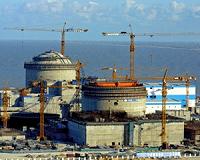 |
Vienna (AFP) May 1, 2010 The UN atomic watchdog said Saturday it is seeking more information about reports of a radioactive waste scandal at the University of Delhi, with one person already dead from radiation poisoning. India's atomic energy regulator the Atomic Energy Regulatory Board (AERB) is currently investigating a claim that Delhi University buried radioactive material on its campus 20 years ago. Local police also blame the university for dumping an irradiation machine containing radioactive cobalt-60 which ended up in scrapyard in New Delhi, where it killed a 35-year-old worker and put seven others in hospital. International Atomic Energy Agency spokesman Marc Vridricaire said the watchdog had become aware "of the possibility of a serious radiation emergency at Mayapuri in New Delhi" via media reports on April 9. It had also seen media reports this week "of a fatality caused by exposure to radiation in Indian scrap metal yards." As a result, the IAEA's Incident and Emergency Centre "has contacted India's Department of Atomic Energy to request information" and offer help, Vridricaire said. The Indian Department of Atomic Energy had "confirmed the initial event," and the AERB had notified the IAEA that "multiple Cobalt-60 sources" had been located and secured, the spokesman continued. Cobalt-60 is categorised as a radioactive source "that can cause permanent injury to a person handling the material even for a short time without appropriate safety measures and protection." The IAEA's Incident and Emergency Centre was "continuing to seek further information on this event," Vridicaire said. "And the IAEA stands ready to assist Indian authorities upon request." The incidents at Delhi University have highlighted the lax enforcement of waste disposal laws in India and raised fears of further contamination from the university, the city's biggest institute with 300,000 students spread over two sites. Ramesh Chandra, a professor in the chemistry department, told the Times of India on Friday that his counterparts in the physics faculty had buried 20 kilograms of low-grade radioactive waste in a pit on campus 20 years ago. "Instead of handing over the hazardous material... for proper disposal, they just buried it," he said. "Though it's been 20 years the buried isotopes of substances like uranium could still be active." Singh said the regulator was looking into waste management by the university and would scrutinise the new allegations by Chandra. "We will verify the professor's claims. If toxic waste is found, then we will take strict action against the university," Singh said. Delhi University declined to comment on the issue when contacted by AFP. The gamma irradiation machine found in the Delhi scrapyard earlier this month was imported by the university in 1980, but had not been used since 1985. It was sold to scrap dealers at auction in February.
Share This Article With Planet Earth
Related Links Nuclear Power News - Nuclear Science, Nuclear Technology Powering The World in the 21st Century at Energy-Daily.com
 China to build two nuclear reactors in Pakistan: report
China to build two nuclear reactors in Pakistan: reportBeijing (AFP) April 29, 2010 China has agreed to build two new civilian nuclear reactors in Pakistan, a report said Thursday, amid persistent concerns about the safety of nuclear materials in the restive south Asian state. Chinese companies will build at least two new 650-megawatt reactors at Chashma in Punjab province, the Financial Times said. China began building a reactor at Chashma in 1991 and broke ground on a ... read more |
|
| The content herein, unless otherwise known to be public domain, are Copyright 1995-2010 - SpaceDaily. AFP and UPI Wire Stories are copyright Agence France-Presse and United Press International. ESA Portal Reports are copyright European Space Agency. All NASA sourced material is public domain. Additional copyrights may apply in whole or part to other bona fide parties. Advertising does not imply endorsement,agreement or approval of any opinions, statements or information provided by SpaceDaily on any Web page published or hosted by SpaceDaily. Privacy Statement |